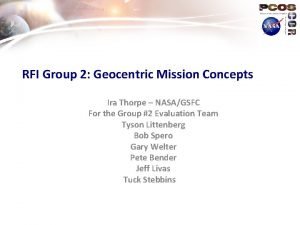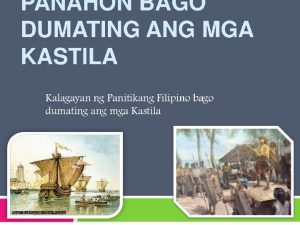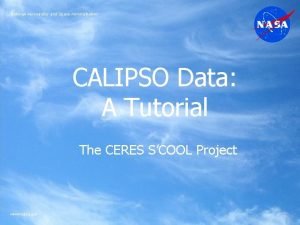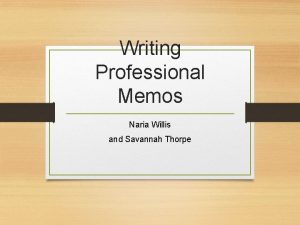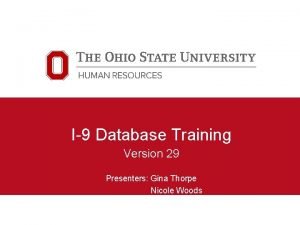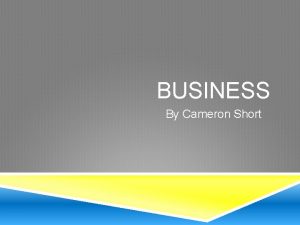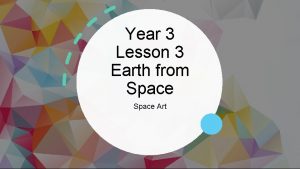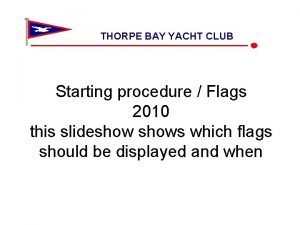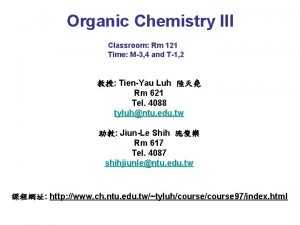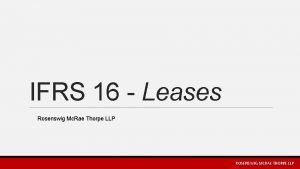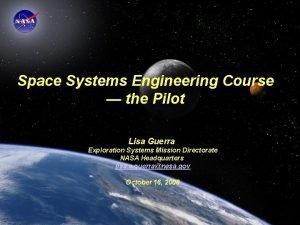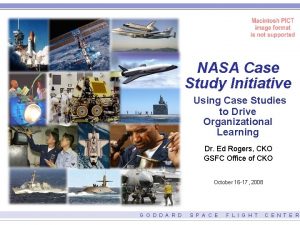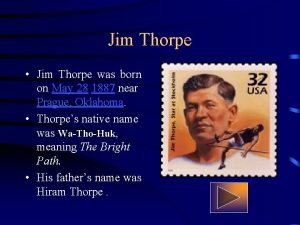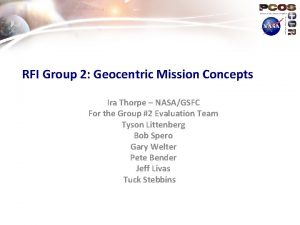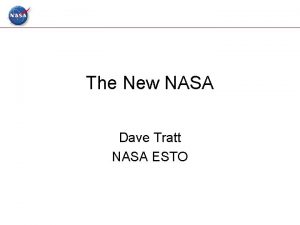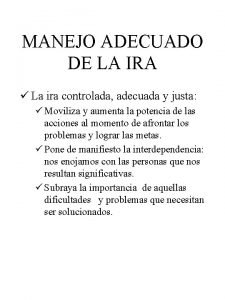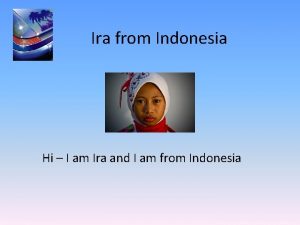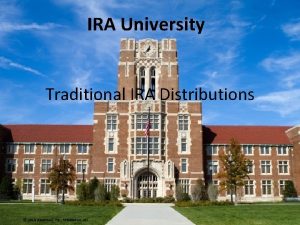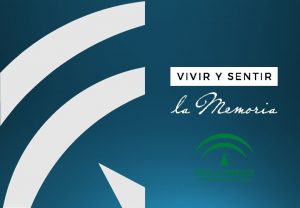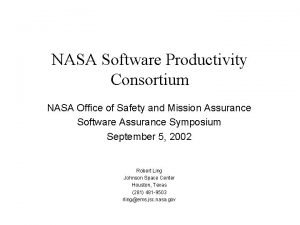LISA Study Office Ira Thorpe NASA LISA Study















- Slides: 15

LISA Study Office Ira Thorpe, NASA LISA Study Scientist Gravitational Wave Science Interest Group Meeting Gaylord National Harbor January 8 th, 2018

What is a Study Office? • A ‘proto-project office’ – Conducts early design studies – Coordinates technology development – Refines science case January 8 th, 2018 GWSIG – AAS 231 – Washington, DC 2

Who is the LISA Study Office? Astrophysics at NASA/HQ NASA PCOS ESA Study Office Leadership Horowitz (manager) Thorpe (scientist) Hornschemeier (dep. Scientist) Rioux (systems engineer) NASA LISA Study Team General Science Community January 8 th, 2018 Core Team Technology Data Analysis Astrophysics Engineering LISA Consortium GWSIG – AAS 231 – Washington, DC 3

What we do: Mission Development • “ground-level” interface with ESA – Regular telecons & frequent visits – In parallel with HQ-HQ discussions • Support ESA & LISA Consortium – Spacecraft Phase 0 study – Payload Phase 0 study • Targeted technical analyses – Phased array antennas for LISA communications – NASA Deep Space Network utilization – Mission analysis (orbits) January 8 th, 2018 The Concurrent Design Facility (CDF) room at ESTEC during the LISA Phase 0 mission study. GWSIG – AAS 231 – Washington, DC 4

What we do: Technology Development • Manage development for potential US contributions – Track development milestones – Harmonize with ESA’s requirements and schedule • Current activities – – – Charge Management (UF) Colloidal Micropropulsion (JPL) Laser system (GSFC) Phase Measurement System (JPL) Telescope (GSFC) January 8 th, 2018 The Concurrent Design Facility (CDF) room at ESTEC during the LISA Phase 0 mission study. GWSIG – AAS 231 – Washington, DC 5

What we do: Science and Analysis • Organize and support US participation in Core Data Science Activities – – Instrument simulator Data challenges Development of proto-pipelines Study of potential US contributions to ground segment / data centers / etc. – Close coordination with ESA & Consortium Sample data set from the last “Mock LISA Data Challenge” of the prior LISA project. January 8 th, 2018 GWSIG – AAS 231 – Washington, DC 6

What we do: Community Interface • Facilitate Study Team Activities – Travel for US members on ESA’s Science Study Team – Travel/Logistics for NASA Study Team • Outreach – New website – Support for decadal preparation – Support / facilitate activities of NASA Study Team / Consoritum January 8 th, 2018 The revamped lisa. nasa. gov which launched this summer GWSIG – AAS 231 – Washington, DC 7

Technology Development

History & Context • 2001 -2011 – Range of technologies developed under auspices of LISA project – Project helped harmonize requirements, interfaces, etc. – Examples: Microthrusters, Phasemeters, Stabilized Lasers, Metrology technologies, etc. • 2011 -2017 – PI-led activities o Lasers, telescopes, stable structures, frequency references, atom interferometry. . . o supported by competitive research funds o Requirements drawn from community – other missions o Micropropulsion: ST 7 -DRS / LISA Pathfinder o Phasemeter: GRACE-FO LRI • 2017 - – Study office “consolidates” technology development January 8 th, 2018 GWSIG – AAS 231 – Washington, DC 9

Philosophy of US Technology Development • Develop full “menu” of possible US contributions – room for decision-makers to satisfy constraints and desires – Will need to downselect eventually • Study Office coordinates interaction with European partners – Development and refinement of requirements and interfaces – Information from and feedback to mission design and development • Guided by input from L 3 Study Team (June 2016) – impact & insight – US heritage – Simplicity of interfaces & integration January 8 th, 2018 GWSIG – AAS 231 – Washington, DC 10

Charge Management • Lead: John Conklin, University of Florida • Summary: Develop non-contact charge management system based on UV LEDs. • Partnership Plan: US contribution to consortium • Development Activities: Develop prototype, test on UF torsion pendulum facility and other facilities. January 8 th, 2018 UF Torsion pendulum facility with simplified “GRS” for use in demonstrating charging at a system level. (Conklin). GWSIG – AAS 231 – Washington, DC 11

Laser System • Lead: Tony Yu & Jordan Camp (GSFC) • Summary: Develop stable laser system • Partnership Plan: direct US contribution to ESA/consortium • Development Activities: Develop prototype based on MOPA architecture. Trade on NPRO vs. ECL MO and fiber amplifiers. Partner with US industry as appropriate. January 8 th, 2018 Prototype ECL-based laser system at GSFC (Numata/Camp/Krainak) GWSIG – AAS 231 – Washington, DC 12

Micropropulsion • Lead: John Zeimer, JPL • Summary: Develop Colloidal Micronewton Thruster System building on ST 7/LPF heritage and lessons learned • Partnership Plan: US contribution to ESA • Development Activities: Modify ST 7 design to address lifetime and reliability and conduct lifetime tests. January 8 th, 2018 Colloidal Micronewton thruster cluster on LPF. (JPL/J. Zeimer) GWSIG – AAS 231 – Washington, DC 13

Phase Measurement Systems • Lead: Bill Klipstein, JPL • Summary: Develop Phase Measurement System building on GRACE-FO/LRI and LISA heritage • Partnership Plan: US contribution to consortium • Development Activities: Reintroduce LISA functionality to GRACE-FO design. Conduct tests and develop prototypes. January 8 th, 2018 Laser Ranging Processor (FM) for GRACE-FO LRI (JPL/Klipstein) GWSIG – AAS 231 – Washington, DC 14

Telescope Systems • Lead: Jeff Livas (GSFC) • Summary: Develop and test LISA telescope system. • Partnership Plan: US contribution to ESA/ consortium, possibly to include some I&T of related items. • Development Activities: Design, purchase, and test telescope prototypes for dimensional stability and scattered light. Partner with US industry as appropriate. January 8 th, 2018 (top) Telescope functional prototype for scattered light tests. (bottom) Draft mechanical design (yellow) GWSIG – AAS 231 – Washington, DC 15
